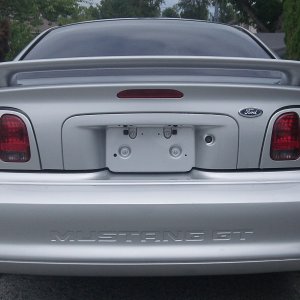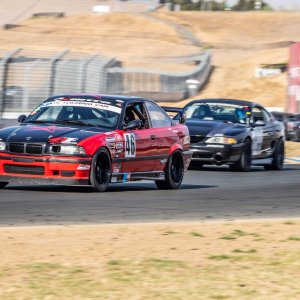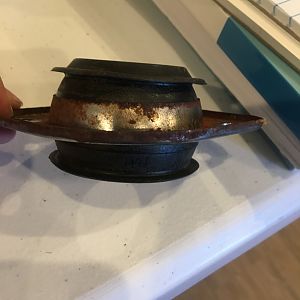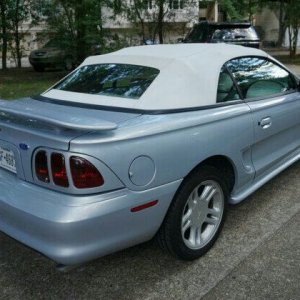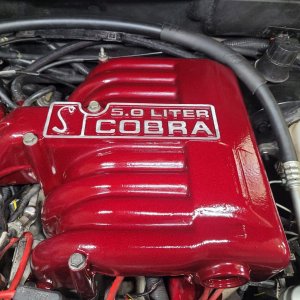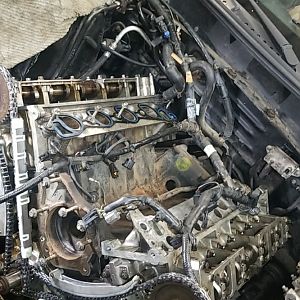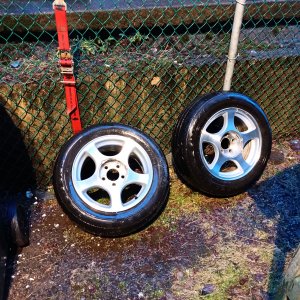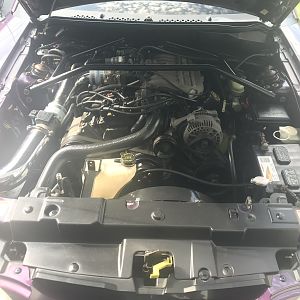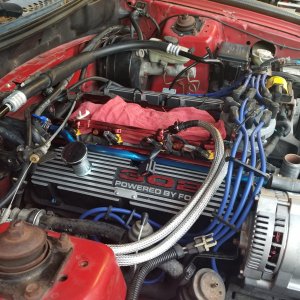[h=4]Wideband/Narrowband Tuning[/h]A narrowband will report a stoich switch
before a wideband will, if it doesn't then something isn't right
a widband
is nice but it not absolutely necessary to dial in fuel, with a known curve you
can watch the kams peal the fuel curve into place
the easy way to tell if
you maf transfer is correct is that your wideband AFR will stay consistent, if
your fuel is constantly jumping all over the place
then your maf transfer is
off, but if your LAMBSEs are static and your AFR is off by a percentage then you
can make that correction with the SLOPE(s)
for example, lets say you
have your fuel table setup so that from 0 to 75 perload your LAMBSE is 14.64, at
90 to 105 load LAMBSE is 12.8, 120+ load LAMBSE is 11.8 (see A9L2 for example)
with all lambse multipliers null (set to 1 = no effect on lambse) including
the global open loop fuel multiplier scalar null (set at 1.00) your lambse will
be what we demanded in the fuel table
at WOT lambse drops to 11.8 (perload
exceeds 120) yet the wideband stays consistent reading 15.5 AFR, you can very
easily drop the high slope from say 40 to 34.5 and in the next pull the WOT
AFR will be
exactly 11.8, now everything over the injector breakpoint
is going to have a kam correction of 1.00 since your linear flow fuel is dialed
in !!
The only 2 variables remaining are the low slope and breakpoint, I
start off by setting the breakpoint high, say 0.000020 (GUFB = ~6) for example,
then adjust the low slope to
get idle right where it needs to be, I then re
enable closed loop and let the hegos and adaptives dial in the fuel, once the
kams have learned you can organize the
mafv numerically in the datalog and
see how the kams have adapted, if you have a kam correction less than 1.00 in
the lower voltages of the maf curve
then you know you need to increase the
low slope, REMEMBER, you must dial in the low slope BEFORE you can dial in the
breakpoint as it will be constantly moving
once you have the low slope
dialed in and the high slope dialed in you'll see exactly where the breakpoint
is as the KAM's will not be 1.00 in that MAF voltage range
[h=4]Open Loop / Closed Loop[/h]In open loop the lambse's do not respond to hego
feedback, the lambse calculated from the fuel table(s) and multipliers is what
you get
since the hegos are cold during startup all ecu's crank into open
loop fuel mode, one can logically figure out that since the hegos can
only
report STOICH, that open loop must be entered at WOT and high loads as well
where enrichment is needed (more fuel than stoich)
during closed loop
the ecu constantly adds and subtracts lambse to get the hego to switch
if
the hego is lean ( < 0.4 volts) then the ecu drops the lambse to enrichen the
mix until the hego switches rich ( goes above > 0.4 volts)
once the hego
has switched rich, the ecu then increases lambses to get it to switch lean again
in a never ending
closed loop
once the hegos are controlling
fuel correctly, the ecu will save that fuel correction in the KAMRF data and use
it the next time the ecu is in that cell (load and rpm range)
the
narrowbands and ecu can dial in your fuel much more accurately than a human can
by looking at a wideband and making adjustments
[h=4]Closed Loop Tuning / KAMRF[/h]by datalogging and comparing MAF voltage to
KAMRF we can dial in fuel perfectly
but since the hegos only report stoich
they can not be used to dial in WOT fuel... or can they?
the beauty about
mass air is that you tune the ecu to the peripherals not specifically to the
engine
by this i mean you don't dial in a VE table to calculate fuel like
you would in a speed density setup
once you have your maf and injectors
dialed in,
so long that your not exceeding their capacity, your fuel will
be exactly where you set it
its highly recommended to have a wideband
for dialing in WOT but if you don't have a wideband you can still dial in your
fuel by letting the hego's do it for you
the ecu will default to open loop
at WOT, in order to
force closed loop at wot you MUST set the WOT
Breakpoint (threshold) to max either 5.1 volts or 1023 ad counts
since
relative_throttle position can never reach that the WOT flag will never be set,
you must ALSO disable the OL vs RPM and OL vs ECT functions from forcing you
into open loop
the easiest way to do this is to set the time delay scalars
to 20 seconds, you can now use the hegos to dial in WOT fuel, it would be very
wise to pull a few degrees of timing out
to prevent a bunch of heat in the
engine, an engines burns hottest at just a tad leaner than STOICH, and we all
know HEAT MAKES POWAH
so by pulling out say 6 degrees or so you will reduce
the amount of heat in the engine and make it safer to beat on at STOICH
for
example, with a dialed in low and high slope your kams might look like this
at 1.5 mafv and below, the kams fluctuate between 0.97 to 1.03 which is
perfectly acceptable
at 1.8 mafv kams=1.05
at 2.0 mafv kams=1.06
at
2.2 mafv kams=1.04
from 2.3 to 5.0 mafv kams fluctuate between .98 and 1.02
you then know you need to reduce the breakpoint to give it a little more
fuel where the slopes meet which is approx. 2.0 mafv in the example given
think of it like this
low slope=low load, cruise and idle
high slope=high load, wot and aggressive acceleration
breakpoint, is the
center of where it mixes both together
in every tune i make, i demand a set value across the table for a specific
perload for example:
I demand 14.64 (stoich) up to a perload of 75% of the
maximum engine load (no boost) and 12.8 at perloads of 90% and greater
I
drop the lambse to 11.8 at a perload of 120+ (n/a engine can't reach perload
greater than 100% when tuned correctly)
the O/L fuel table fn1362 and the
stabilized fuel table fn1360 do the same thing, only different is stabilized
table has rpm input instead of ect, at startup the base fuel table is used
regardless until the ECT stable flag is set
in which it switches to the
stabilized fuel table fn1360, as long as you reasonable values in the tables for
it makes no difference tune wise
Note: The RPM vs Load Open Loop Function is
ONLY ACTIVE once the ECT Stable Flag is set, setting the function to all 0s will
not force open loop until the ECT Stable flag is set.
the lambse is the afr
your telling the ecu you want, if your lambses are 12.5 at WOT and you want them
at 11.8 you need to go to the fuel table and change it from 12.5 to 11.8 in
those cells
its very difficult to get the fuel dialed in with closed loop
throwing you around, once you get your fuel right you can then allow closed loop
and adaptives to do their thing and dial your fuel in perfect, only a narrowband
can dial your fuel in perfect, unless you want to get a lab spec wideband and
spend hours makes decimal changes to your fueling
[h=4]STFT to Lambse[/h]Short Term Fuel Trim is the equivalence ratio of stoich,
It is the exact same representation of Lambse except in percentage instead of
lambda.
To put this into perspective, lets say at WOT we have a perload of
140
This gives us a LAMBSE of 11.8 from our example base fuel table we
described above
14.64 / 11.8 = 1.240% fuel equivalence ratio (STFT)
thus we will have a STFT of 24% since we are adding 24% more fuel
Now, lets say for example, we are in closed loop and our STFT has a
negative value of -18
14.64 * 1.18 = 17.27 (Lambse)
as you can
infer, a negative STFT means its removing fuel, so you MULTIPLY to get the
lambse
a positive STFT means it is adding fuel, so you divide to get the
Lambse
So lets say for example, we have a STFT of 18
14.64 / 1.18 =
12.4 (Lambse)
for quick reference heres a table to break it down and
help understand it better
STFT
Lambse
-1
14.78 = 14.64 * 1.01
-2
14.93 = 14.64 * 1.02
-4
15.22 = 14.64 * 1.04
-8
15.81 = 14.64 * 1.08
-12
16.39 = 14.64 * 1.12
-16
16.98 = 14.64 * 1.16
-18
17.27 = 14.64 * 1.18
-20
17.56 = 14.64 * 1.20
-25
18.30 = 14.64 * 1.25
0
14.64 = 14.64 / 1.00
1
14.49 = 14.64 / 1.01
2
14.35 = 14.64 / 1.02
4
14.07 = 14.64 / 1.04
8
13.55 = 14.64 / 1.08
12
13.07 = 14.64 / 1.12
16
12.62 = 14.64 / 1.16
18
12.40 = 14.64 / 1.18
20
12.20 = 14.64 / 1.20
25
[h=4]SUMMARY[/h]just a quick recap,
YOU CAN NOT DIAL IN FUEL USING THE WOT
FUEL MUTIPLIER OR THE FUEL TABLES!!!
the wot multiplier and fuel tables only
modify lambse THEY DO NOT DIAL IN FUELING!!
you can use the wot fuel
multiplier if you want, in fact I use it on all my mail order tunes, but
remember though its a multiplier on lambse it can't dial in fuel
so remember
if your demanding 13 and your wideband is saying 12 even if your in boost, your
running rich, once again the purpose in this thread is that the wideband reading
is
useless without knowing the lambse, their is no possible way to know if
your rich or lean since its relative to lambse
if you want a WOT AFR
of 11.8 and your wideband reads an AFR of 11.8, yet the LAMBSE is 12.5 (the
computer wants 12.5 AFR) THEN YOU ARE RICH and you need to change your fuel
table to 11.8 instead of 12.5 and then readjust your fueling so your wideband
then reads 11.8 again which would coincide with your lambse, since your 1.059%
richer now if you just changed the lambse to 11.8 without changing your fueling
you'll be down to around 11.14
LAMBSE is the AFR the ecu is
demanding, widebands read the actual AFR, thats why you dial in fuel by
getting the actual AFR (wideband) to match the demanded afr LAMBSE
table
rescaling has no effect on FUELING
for the record, no one has to rescale any
tables, its
ONLY done to gain more control, if you want to do it the
quick way you can simply increase the sarchg (cubic inch displacement scalar)
and adjust your tables accordingly, same principle
LAMBSE is the afr you
tell the ecu you want, once fuel is dialed in correctly, the wideband will spit
out the same AFR as LAMBSE
the lambse should be whats in the fuel table
unless your in closed loop and its varying around stoich or if theres a
multiplier thats modifying the lambse, like the wot multiplier, global fuel
scalar, startup enrichment, lug multipliers, etc..
the injector slopes have
nothing to do with lambse
its often easiest to get fuel close in open loop
then enable closed loop and use the kams to mold the fueling into place
perfectly
the older ecu's used rpm as a variable for the breakpoint, where
as with the newer ecu's its static thus the single breakpoint lb fuel scalar

